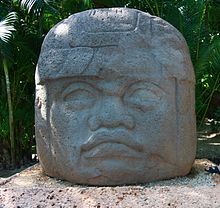La Venta
[4][5] La Venta is located at the nexus of four different ecosystems: marshes, mangrove swamps, tropical forest, and the Gulf of Mexico.
Large basalt stones were brought in from the Tuxtla Mountains, but these were used nearly exclusively for monuments including the colossal heads, the "altars" (actually thrones), and various stelae.
For example, the basalt columns that surround Complex A were quarried from Punta Roca Partida, on the Gulf coast north of the San Andres Tuxtla volcano.
"[6] Today, the entire southern end of the site is covered by a petroleum refinery and has been largely demolished, making excavations difficult or impossible.
While it may have included as-yet-undiscovered regal residences, habitation for the non-regal elite and the commoners were located at outlying sites such as San Andrés.
Complex C, "The Great Pyramid," is the central building in the city layout, is constructed almost entirely out of clay, and is visible from a distance[quantify].
[8] Surrounded by a series of basalt columns, which likely restricted access to the elite, it was erected in a period of four construction phases that span over four centuries (1000 – 600 BCE).
Though there are not any actual houses remaining in this area (or anywhere at La Venta) "a chemical evaluation of the soil revealed unusual concentrations of phosphate, indicating the possibility it had been a residential zone.
"[17] The arrangement of the mounds, platforms, complexes, and monumental artifacts at La Venta created a unique civil and ceremonial center that, in the words of Rebecca Gonzalez-Lauck, constitutes "one of the earliest examples of large-scale ideological communications through the interaction of architecture and sculpture".
The major basalt quarry for the colossal heads at La Venta was found at Cerro Cintepec in the Tuxtla Mountains, over 80 km away.
[20] La Venta is perhaps the largest Olmec city and it was controlled and expanded by an extremely complex hierarchical system with a king, as the ruler and the elites below him.
It is possible that the signs of status exist in the artifacts recovered at the site such as depictions of feathered headdresses or of individuals wearing a mirror on their chest or forehead.
[22] To add to the mystique of La Venta, the alluvial soil did not preserve skeletal remains, so it is difficult to observe differences in burials.
The only organics recovered at the site include traces of long bones, a burned skullcap, a few milk teeth, a shark's tooth, and stingray spines—all found in the basalt tomb [Structure A-2]."
[25] Inside the platform, researchers discovered badly preserved bones covered in a red pigment, cinnabar, a substance used in similar Mesoamerican cultures to denote status.
Mirrors are also suspected to be a mark of rank among the Olmec, as stelae and other monuments display leaders and priests wearing them on their chest and on their foreheads.
[26] Rust (2008) discovered "urn burials" in Complex E (residential area) where fragments of bone and teeth were buried in clay pots.
"[24] "For decades, certain scholars have used shamanism as an explanatory paradigm for considering the monuments of La Venta... one of the most important ceremonial-civic centers of the Middle Formative era.
[29] Structures at La Venta show that "various architectural-sculptural canons were firmly established—canons that were, in essence, used in civic-ceremonial constructions throughout the cultural history of ancient Middle America.
[30] Ocean creatures were also sacred to the Olmec—Pohl (2005) found shark teeth and sting ray remains at feasting sites at San Andres and it is clear that those at La Venta shared in the same ideology.
"Zoomorphic forms reference sharks and birds, and both collections contain representations of the quincunx symbol, a conceptualization of the cosmos in Mesoamerican thought.
This local exchange, and the resulting relationship system, is important, though, because it increased and consolidated the power of the elites with luxury goods and feasting foods like cacao and maize beer.
[33][34] "Participation in regional and long-distance exchange networks provided the La Venta ruling elite with a significant source of legitimizing power.
[35] In 1955, Drucker led a new excavation, funded again by the National Geographic Society, concentrating on Complex A and finally reaching the subsoil at the site, established stratigraphy to discover the constructional history.
[8] At this point most of the site was still unexcavated[9][36][37] and in a strongly worded passage Heizer reported that the site was inadequately protected by the Mexican government and a wave of illegal excavations followed the departure of the archaeologists, as well as damage by urban sprawl, the national oil company, Pemex, and the removal of large monuments to museums (without leaving markers as to their original positions).
[40] They also obtained better carbon samples in order to achieve one of the key goals of the excavation of La Venta—proving that the Olmec were a distinct and separate culture that pre-dates the first Maya settlements.
Rebecca Gonzalez-Lauck led an INAH (Instituto Nacional de Antropología e Historia) team on several digs at La Venta in the 1980s.
[42] “Because of extremely poor viewing conditions in the tropical rainforest, different parts of La Venta were discovered piecemeal, and it was decades before scholars realized that all the platforms and stone sculptures found in the vicinity were part of a single site, an ancient city that was occupied from 900-400 BCE.”[13] Phases I- IV are dated based on radiocarbon dates from Complex A, with approximately one hundred years between each phase.
[5] On January 11, 2009, 23 ancient Olmec sculptures were damaged with a mixture of salt water, grape juice, and oil by a group attempting to perform a supposed pre-Columbian ritual to bring about peace and world-healing.
The group of two Mexicans, Roberto Conde Díaz and José Pablo Megenes Jasso, and an American citizen, Wanda Ivette Aguilar were alleged members of a Christian sect called "Nueva Generación".











Courtesy George & Audrey Delange